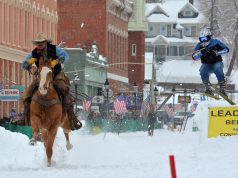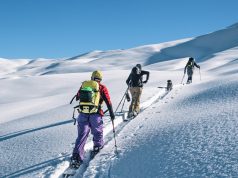
As the Government Affairs Director for the International Mountain Biking Association, Jenn Dice heads up the lobbying arm of the leading mountain biking advocacy group in the United States. She rode into the job by accident, after getting involved in endurance mountain bike racing. With the recent controversy over adding mountain bike access along Boulder’s western foothills still simmering, Boulder Weekly caught up with Dice to get her take on new trails for Boulder riders, the impacts of demographics on decision makers and the future of IMBA.
Boulder Weekly: First, give us a bit of personal background. When did you start mountain biking, and how did you end up becoming involved in IMBA?
Jenn Dice: I started mountain biking in earnest 12 years ago when I signed up for the Leadville Trail 100 mountain bike race. I wanted a big goal, and this was my first race ever, and it scared me to death. Fear is a great motivator, and in training for that race, I jumped into mountain biking with both feet. Since then I have done dozens of races, mostly endurance distance, 50- and 100-milers.
I have always been a lobbyist since graduate school at KU, in a variety of jobs at the local, state and federal level. I was an IMBA member and met some of the IMBA staff at Veloswap, who told me about the job opening. Isn’t there a saying about, “if you fall in love with your work, you will never work a day in your life”?
It turned out combining my favorite hobby of mountain biking with my professional career of lobbying was the best decision I have made. I work with some incredible people and am lucky to be in the bike industry.
BW: And tell us a bit about IMBA. What exactly do you guys do?
JD: IMBA makes sure you have a great place to ride, close to home. We build many types of trails, advocate for access and funding, promote land conservation that is bike-friendly, and our 750 affiliated clubs, and 80,000 supporters, are out getting people on mountain bikes, holding festivals and races, and conducting close to one million hours annually in volunteer trailwork. Two of our highly successful clubs locally are the Boulder Mountain Bike Alliance (BMA) and the Colorado Mountain Bike Association (COMBA).
IMBA has a partnership agreement with the U.S. Forest Service, Bureau of Land Management, National Park Service, US Army Corps of Engineers and several state governments. We help these federal partners build new trails and consult with them on trail build ing, management, environmental compliance and a host of recreation issues.
The proposed mountain bike access trail in Boulder that would run along the western foothills was recently a hot political topic. Obviously, that trail isn’t going to happen, but a new trail was approved, and IMBA will continue to work for bike access.
BW: What’s happening now and what can we see in the future? Are there some cool things coming down the pipeline for Boulder mountain bikers that IMBA is involved with?
JD: Two exciting trail openings are coming up. Betasso Preserve’s new trails just opened on May 17, and Valmont Bike Park opens June 11. While we were disappointed that the north-south connector in the West TSA didn’t happen, we were encouraged that the City Council directed staff to explore new trails at Anemone Hill/Settlers Park, located in the West Pearl/Sunshine Canyon area and to get cyclists from the Boulder Creek path out to Betasso’s connector off of the dangerous highway cyclists must currently negotiate. Both projects are sorely needed in Boulder. A lunch loop in the heart of town would be embraced by the local mountain bike community who would help build and maintain this trail system. IMBA consults with hundreds of cities and counties throughout the world on new trails construction and management. Shareduse trails work in cities with bigger populations and visitor numbers than Boulder, they can work here, too. Recreation ecology has shown the impact of hiking and biking to be simi lar, with horses and OHV’s doing more damage to trails. Hikers and bikers can get along on the same trail system, and it is important that our current leaders encourage sharing.
BW: What about statewide?
Colorado has a lot of riding already, but are there any new projects that might provide a nice day trip for local riders?
JD: For a day trip, we encourage checking out some new IMBA built trails at the Golden Bike Park, and the Curt Gowdy State Park, near Cheyenne, Wyo., is incredible! Also there are new trails at Buffalo Creek called Raspberry Ridge and an extensive new trail system at Lory State Park near Fort Collins. A longer trip to Grand Junction has some of the best new technical trails in the state around the Tabeguache Trail System.
We’ve been talking about trails, but mountain biking and recreation in general is evolving pretty quickly. Keystone has a pretty big downhill and freeride bike scene, and action sports are on the verge of becoming mainstream, if they’re not already.
BW: Do you think that demographics will play a role in getting mountain biking accepted? After all, most kids these days are more interested in action sports than a quiet hike.
JD: Demographics will absolutely play a role, both from a standpoint of new cyclists and with decision makers embracing shared-use trails. School leaders tell us all the time that kids love to ride bikes; they don’t think of it as exercise. Kids just want to play and have fun, and we are seeing an increase in bike parks and urban trails. Jump parks and pump tracks are a great way to get kids off the couch, away from video games and outside having fun. Winter ski resorts are also embracing the summer freeride and downhill mountain bike scene. Mountain biking brings $40 million a summer to British Columbia’s western cities, and U.S. ski resorts are following their lead.
From an access perspective, changing demographics are already changing the national scene. In communities with younger leaders, they realize that the next generation of environmentalists ride mountain bikes. We are bringing new people to the land that care about nature and in many western cities, similar to Boulder, trails shared by hikers and bikers are the norm, not the exception, like here. Even in national parks, we are seeing more park superintendents who understand that kids and families want to explore their park by bicycle. Forty-four national parks now have mountain biking. They want to be relevant to today’s youth and get people out of their RVs and minivans and into their park. President Obama’s new campaign America’s Great Outdoors and the First Lady’s Let’s Move initiatives are both helping get Americans more active and outside, enjoying their public lands. IMBA is a partner in both initiatives, and we see the mountain bike as a big part of the solution. IMBA’s Take A Kid Mountain Biking Day, Oct. 1, will get 30,000 kids on mountain bikes at 300 locations, all in the name of the First Lady’s Let’s Move campaign.
BW: Will this mean that in 10 years it will be impossible for political leaders in Boulder to prevent mountain biking on public trails? Did the battle just get lost in the west TSA area, but the war is just beginning?
JD: We certainly don’t think of it as a battle or a war. We just have a set of open space staff that aren’t using best management practices or the best science available to make trail building and management decisions. They aren’t looking to their peers in other communities to see what many other communities are constructing. They have 58 miles of illegal social trails in the West TSA alone, and many of the other trails are wide, eroded and an environmental mess. The next generation of land managers and elected officials will change that. IMBA’s two trail-building books have sold 30,000 copies worldwide and been translated into French and Spanish. IMBA’s guidelines for sustainable trail construction are SOP [standard operating procedure] in many communities, just not here. Yet. But it is definitely getting better, and things like Betasso and Valmont are the silver lining.
BW: For mountain bikers who want to make a difference, what’s the best way to get involved?
JD: Join your local IMBA club (BMA and COMBA) to support local trail initiatives and join IMBA to support the national campaign behind mountain biking. IMBA has doubled in size in the past 10 years. We have 44 staff, are working in all 50 states and a dozen countries on some exciting new trail projects and pro-bike policies. It is a great time to be a mountain biker. There are so many great trails to ride and destinations for all types of mountain bikes.
BW: Parting thoughts?
JD: IMBA launched our Public Lands Initiative (PLI) one year ago to help get mountain bikers active in more public land protection bills. There are about a half-dozen proposals we care about in Colorado that if we aren’t at the table for the discussions, we will end up being on the menu and see our trail access erode in the name of land protection or poorly planned resource extraction. We need mountain bikers who want to see great riding in Colorado maintained and expanded, but want to protect the land around their trails from development, we need them to register at imba.com today. We will keep cyclists informed of what could happen to their access in places like Vail, Carbondale, Salida, Breckenridge, Crested Butte, Gunnison, Durango and other communities. The PLI has taken on 25 public lands campaigns nationwide, many in Colorado, to promote bike-friendly land protections.
Respond: [email protected]














